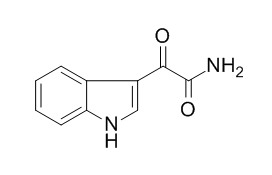Indole-3-glyoxylamide
Indole-3-glyoxylamides are an attractive lead series for continuing development as potential therapeutic agents against prion disease. A number of Indole-3-glyoxylamides have previously been reported as tubulin polymerization inhibitors, exert a cytotoxic effect against multiple cancer cell lines.
Inquire / Order:
manager@chemfaces.com
Technical Inquiries:
service@chemfaces.com
Tel:
+86-27-84237783
Fax:
+86-27-84254680
Address:
1 Building, No. 83, CheCheng Rd., Wuhan Economic and Technological Development Zone, Wuhan, Hubei 430056, PRC
Providing storage is as stated on the product vial and the vial is kept tightly sealed, the product can be stored for up to
24 months(2-8C).
Wherever possible, you should prepare and use solutions on the same day. However, if you need to make up stock solutions in advance, we recommend that you store the solution as aliquots in tightly sealed vials at -20C. Generally, these will be useable for up to two weeks. Before use, and prior to opening the vial we recommend that you allow your product to equilibrate to room temperature for at least 1 hour.
Need more advice on solubility, usage and handling? Please email to: service@chemfaces.com
The packaging of the product may have turned upside down during transportation, resulting in the natural compounds adhering to the neck or cap of the vial. take the vial out of its packaging and gently shake to let the compounds fall to the bottom of the vial. for liquid products, centrifuge at 200-500 RPM to gather the liquid at the bottom of the vial. try to avoid loss or contamination during handling.
Mol Med Rep.2024, 29(2):26.
Tumour Biol.2015, 36(12):9385-93
Food Funct.2022, doi: 10.1039
The Journal of Agromedicine and Medical Sciences2018, 4(1)
J Chromatogr B Analyt Technol Biomed Life Sci.2018, 1080:27-36
Journal of Apicultural Research2021, 60(1)
Front Pharmacol.2024, 15:1439079.
Nutrients.2023, 15(6):1417.
Chinese Pharmacological Bulletin2019, 35(8):1120-1125
Phytomedicine.2021, 2(82):153452
Related and Featured Products
J Nat Prod. 2011 Apr 25;74(4):888-92.
Didemnidines A and B, indole spermidine alkaloids from the New Zealand ascidian Didemnum sp.[Pubmed:
21348447 ]
METHODS AND RESULTS:
Two new indole spermidine alkaloids, didemnidines A (1) and B (2), have been isolated from the New Zealand ascidian Didemnum sp. The structures of the metabolites, determined by analysis of 2D NMR spectra and confirmed via synthesis, embody an Indole-3-glyoxylamide moiety linked to the N(1) position of spermidine, the latter motif being particularly rare among marine natural products.
CONCLUSIONS:
Didemnidine B and a synthetic precursor exhibited mild in vitro growth inhibition of Plasmodium falciparum with IC(50)'s of 15 and 8.4 μM, respectively.
J Med Chem. 2015 Dec 10;58(23):9309-33.
An Orally Bioavailable, Indole-3-glyoxylamide Based Series of Tubulin Polymerization Inhibitors Showing Tumor Growth Inhibition in a Mouse Xenograft Model of Head and Neck Cancer.[Pubmed:
26580420 ]
METHODS AND RESULTS:
A number of Indole-3-glyoxylamides have previously been reported as tubulin polymerization inhibitors, although none has yet been successfully developed clinically. We report here a new series of related compounds, modified according to a strategy of reducing aromatic ring count and introducing a greater degree of saturation, which retain potent tubulin polymerization activity but with a distinct SAR from previously documented libraries. A subset of active compounds from the reported series is shown to interact with tubulin at the colchicine binding site, disrupt the cellular microtubule network, and exert a cytotoxic effect against multiple cancer cell lines.
CONCLUSIONS:
Two compounds demonstrated significant tumor growth inhibition in a mouse xenograft model of head and neck cancer, a type of the disease which often proves resistant to chemotherapy, supporting further development of the current series as potential new therapeutics.
Eur J Med Chem. 2011 Sep;46(9):4125-32.
Discovery of 6-substituted indole-3-glyoxylamides as lead antiprion agents with enhanced cell line activity, improved microsomal stability and low toxicity.[Pubmed:
21726921 ]
A series of highly potent Indole-3-glyoxylamide based antiprion agents was previously characterized, focusing on optimization of structure-activity relationship (SAR) at positions 1-3 of the indole system.
METHODS AND RESULTS:
New libraries interrogating the SAR at indole C-4 to C-7 now demonstrate that introducing electron-withdrawing substituents at C-6 may improve biological activity by up to an order of magnitude, and additionally confer higher metabolic stability. For the present screening libraries, both the degree of potency and trends in SAR were consistent across two cell line models of prion disease, and the large majority of compounds showed no evidence of toxic effects in zebrafish.
CONCLUSIONS:
The foregoing observations thus make the Indole-3-glyoxylamides an attractive lead series for continuing development as potential therapeutic agents against prion disease.



